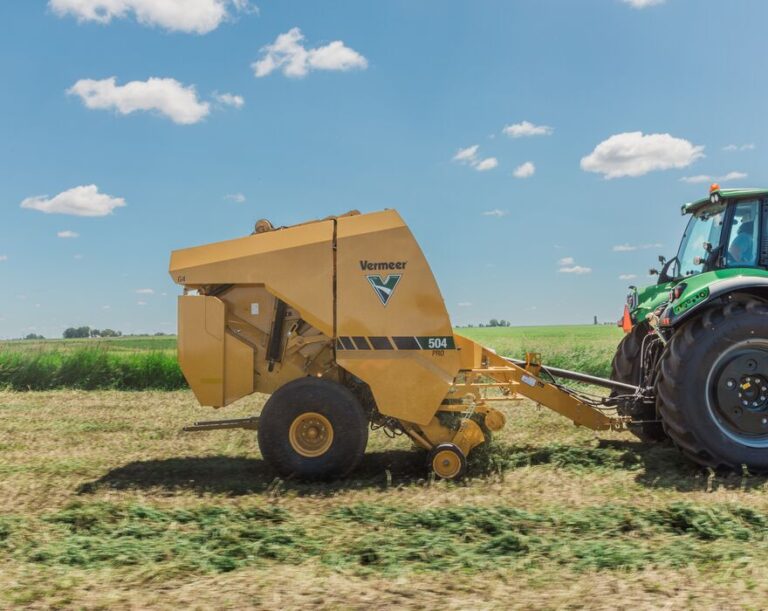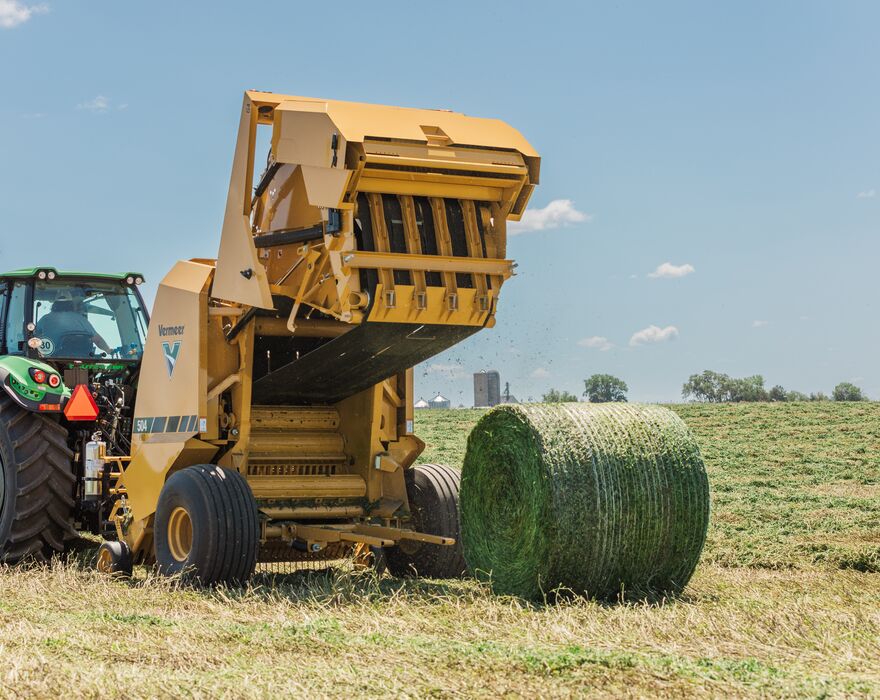
Features that enable ease of operation with the Pro G4 baler
October 2024
The Pro G4 silage balers are the newest addition to the Vermeer forage lineup.
There are two new models available for hay and forage producers — the 504 Pro G4 (5-ft by 4-ft bales) and 604 Pro G4 (6-ft by 4-ft bales). Pro G4 balers are built for producers who aim to provide nutrient-dense silage bales for their herds and want a reliable baler to do so. These heavy-duty balers are engineered for unmatched performance across various crop types and moisture levels — setting a new standard for silage production.
Not only will these new baler models be versatile and reliable balers in the silage market but are also designed to be easier for operators to run and adjust their machine to fit various baling conditions while in the field.
Take a look at the features that make this baler designed for easier operation and tips to maximize your productivity.
Vermeer Pro G4 baler: Designed to make silage baling easier
Operating and maintaining a silage baler doesn’t have to be complicated – with the Pro G4 silage baler lineup, the Vermeer forage team wanted to simplify silage baling for hay and forage producers. With a team of talented engineers and product experts, the Pro G4 series balers are designed to be more convenient to operate and provide a better baling experience.
Here are the top Pro G4 baler features and tips for the round baler.
Atlas Pro™ Control System
The Atlas Pro control system, implemented on all Signature, Premium and Pro-series Vermeer balers, was developed with highly productive hay and forage producers in mind. This monitor gives operators extensive capabilities to track and adjust baler functions right from the cab. Adjustment capabilities include bale size, net tension, density and number of wraps. If you’re looking to make more data-driven decisions on your operation, the Atlas Pro Control system can help you do just that. Easily track information like bale weight, real-time moisture, bale shape and bales per hour.
The monitor is intuitive and allows operators to make adjustments with ease. A 7-in (17.8-cm) color touchscreen, icons, font size and symbols were designed for ease of reading in both day and nighttime operations.
The Atlas Pro system automatically captures statistics while working in the field. This data can help farmers and ranchers track and manage baling operations — whether they are wanting to check their individual fields or are a custom operator serving multiple producers. Some of the information captured by the Atlas Pro system includes the day a specific field was baled, number of bales per field, average moisture and tonnage per field, bales per hour and the total time taken to bale a field. If you are selling based on tonnage or bale count, the Atlas Pro Control system can provide that information for you.
Once you finish baling in the field or at the end of hay season, you can evaluate the data to help make informed decisions, improve productivity and even have an accurate resource for invoicing.
Drop floor
When baling high-moisture crops, plugging the baler pickup can seem unavoidable. Many hay and forage producers would likely agree that a plugged baler is one of the most inconvenient things to occur during baling.
Whether you’re working around incoming weather or trying to bale at a specific moisture level, unplugging your baler is the last thing you want to be doing when hay is on the ground.
With the Pro G4 baler, you can clear a plug right from the cab. The spring design helps to reduce plugs overall, but if one does occur, the spring-mounted floor can be dropped hydraulically from the in-cab monitor to release the crop that is in the baler pickup. Being able to unplug the baler right from the cab can reduce time spent out of the cab and enable you to drive at your desired field speed with confidence.
Netwrap system
The netwrap system on the Pro G4 baler is designed to simplify how net wrap is loaded into the baler.
With a rear-load netwrap system, you no longer need to maneuver around the tongue or onto a platform with a heavy roll of netwrap to refill the baler net. This design has beneficial for operators, as you are no longer loading from the front and routing the netwrap from the top of the baler. For farmers and ranchers who have run a baler with a front-load netwrap system, loading netwrap in a Pro G4 model will be a significant difference in effort and time.
The Pro G4 balers are designed to keep you in the cab longer — which is why many baler functions can be done right in the cab through the monitor.
Adjusting the hydraulic net tension on your baler can be done right in the cab. Simply adjust the optimal net tension and spread through the Atlas Pro Monitor, rather than doing it from outside the machine. The net fuel gauge sensor monitors how much net wrap is left on the roll, similar to a fuel gauge in a car. This technology is beneficial so you can see when you are low on net wrap without checking at the back of the machine and can grab another roll if needed if you are near where the net wrap is left in the field.
The routing system within the baler itself has also been simplified and will distribute the right amount of net to the bale regardless of the PTO speed.
Protect the quality of your chopped hay
Getting your crop baled is often seen as the first step to feeding or selling a high-quality forage. But before you even begin baling, it’s important to consider the type of netwrap you want to run in your baler.
For hay and forage producers who wrap their silage bales, the type of netwrap used may not seem important. If the bales are getting wrapped in plastic, does the first layer of netwrap matter that much? Ed Henning with the Vermeer Forage group said the netwrap you choose is more important than you might think.
“For plastic-wrapped bales in particular, the netwrap you use can impact the quality of the bale,” Henning said. “When baling heavy bales, you want to get all the loose stems laid flat and wrapped in tight. If you don’t, a piece of stem may tear a hole in the plastic wrap and allow air into the bale. Even just a small tear in the wrap can drastically decrease the quality and longevity of that chopped hay.”

Investing in a high-performance netwrap helps protect the time and energy you’ve put into growing and harvesting quality forage — that’s why many hay and forage producers choose Vermeer® Net for their operations. Vermeer Net is a strong, durable netwrap to keep bales wrapped tightly — which is essential when wrapping chopped hay bales. Vermeer Net is made with a heavy-duty, high density polyethylene (HDPE) for maximum durability and protection. If you are often baling a variety of crop types with differing moisture levels, Vermeer Net can do both wet and dry hay.
If you’ve been thinking of expanding into silage baling but haven’t found the machine that fits your needs, the Pro G4 series balers could be the answer you’re looking for. The Pro G4 series balers are not just another baler — but a baler that you can trust to perform no matter what crops you may encounter. These balers are heavy duty, reliable and are built to take the complications and headaches out of baling wet and dry hay.
For more information on the 504 Pro G4 or 604 Pro G4 balers or other hay and forage products, reach out to your local Vermeer dealership.
###
Vermeer Corporation reserves the right to make changes in engineering, design and specifications; add improvements; or discontinue manufacturing at any time without notice or obligation.
Equipment shown is for illustrative purposes only and may display optional accessories or components specific to their global region.
Please contact your local Vermeer dealer for more information on machine specifications.
Vermeer, the Vermeer logo, Atlas Pro and the Black, White, Green bale wrap color scheme (Vermeer Net) are trademarks of Vermeer Manufacturing Company in the U.S. and/or other countries.
© 2024 Vermeer Corporation. All Rights Reserved.
